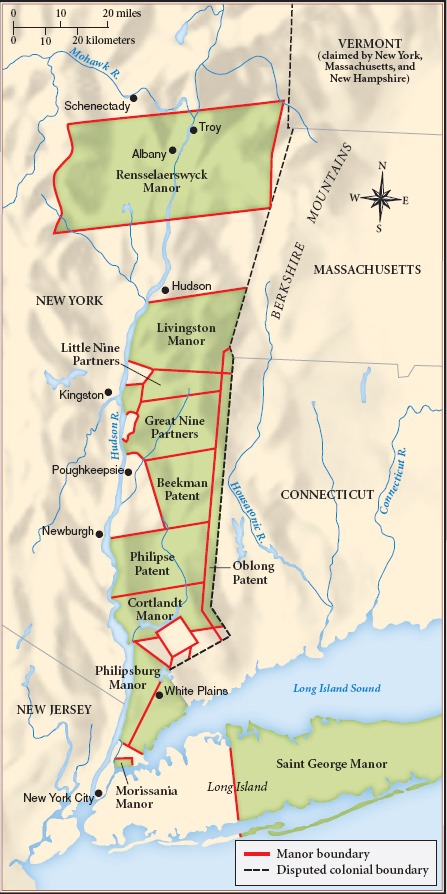America’s History: Printed Page 120
America: A Concise History: Printed Page 102
America’s History: Value Edition: Printed Page 101
Economic Growth, Opportunity, and Conflict
Previously home to New Netherland and New Sweden, the Mid-Atlantic region was already ethnically diverse before England gained control of it. The founding of Pennsylvania and New Jersey amplified this pattern. Fertile land seemed abundant, and grain exports to Europe and the West Indies financed the colonies’ rapid settlement (America Compared). Between 1720 and 1770, a growing demand for wheat, corn, and flour doubled their prices and brought people and prosperity to the region. Yet that very growth led to conflict, both within the Middle colonies and in their relations with Native American neighbors.

Tenancy in New York In New York’s fertile Hudson River Valley, wealthy Dutch and English families presided over the huge manors created by the Dutch West India Company and English governors (Map 4.1). Like Chesapeake planters, the New York landlords aspired to live in the manner of the European gentry but found that few migrants wanted to labor as peasants. To attract tenants, the manorial lords granted long leases, with the right to sell improvements such as houses and barns to the next tenant. They nevertheless struggled to populate their estates.
Most tenant families hoped that with hard work and ample sales they could eventually buy their own farmsteads. But preindustrial technology limited output. A worker with a hand sickle could reap only half an acre of wheat, rye, or oats a day. The cradle scythe, a tool introduced during the 1750s, doubled or tripled the amount of grain one worker could cut. Even so, a family with two adult workers could reap only about 12 acres of grain, or roughly 150 to 180 bushels of wheat. After saving enough grain for food and seed, the surplus might be worth £15 — enough to buy salt and sugar, tools, and cloth, but little else. The road to landownership was not an easy one.
Conflict in the Quaker Colonies In Quaker-dominated Pennsylvania and New Jersey, wealth was initially distributed more evenly than in New York, but the proprietors of each colony, like the manor lords of New York, had enormous land claims. The first migrants lived simply in small, one- or two-room houses with a sleeping loft, a few benches or stools, and some wooden platters and cups. Economic growth brought greater prosperity, along with conflicts between ordinary settlers and the proprietors who tried to control their access to land, resources, and political power.
William Penn’s early appeals to British Quakers and continental Protestants led to a boom in immigrants. When these first arrivals reported that Pennsylvania and New Jersey were “the best poor man’s country in the world,” thousands more followed. Soon the proprietors of both colonies were overwhelmed by the demand for land. By the 1720s, many new migrants were forced to become squatters, settling illegally on land they hoped eventually to be able to acquire on legal terms.
Frustration over the lack of land led the Penn family to perpetrate one of the most infamous land frauds of the eighteenth century, the so-called Walking Purchase of 1737, in which they exploited an old (and probably fraudulent) Indian deed to claim more than a million acres of prime farmland north of Philadelphia. This purchase, while opening new lands to settlement, poisoned Indian relations in the colony. Delaware and Shawnee migration to western Pennsylvania and the Ohio Valley, which was already under way, accelerated rapidly in response.
Immigrants flooded into Philadelphia, which grew from 2,000 people in 1700 to 25,000 by 1760. Many families came in search of land; for them, Philadelphia was only a temporary way station. Other migrants came as laborers, including a large number of indentured servants. Some were young, unskilled men, but the colony’s explosive growth also created a strong demand for all kinds of skilled laborers, especially in the construction trades.
Pennsylvania and New Jersey grew prosperous but contentious. New Jersey was plagued by contested land titles, and ordinary settlers rioted against the proprietors in the 1740s and the 1760s. By the 1760s, eastern Pennsylvania landowners with large farms were using slaves and poor Scots-Irish migrants to grow wheat. Other ambitious men were buying up land and dividing it into small tenancies, which they lent out on profitable leases. Still others sold farming equipment and manufactured goods or ran mills. These large-scale farmers, rural landlords, speculators, storekeepers, and gristmill operators formed a distinct class of agricultural capitalists. They built large stone houses for their families, furnishing them with four-poster beds and expensive mahogany tables, on which they laid elegant linen and imported Dutch dinnerware.
By contrast, one-half of the Middle colonies’ white men owned no land and little personal property. Some were the sons of smallholding farmers and would eventually inherit some land. But many were Scots-Irish or German “inmates” — single men or families, explained a tax assessor, “such as live in small cottages and have no taxable property, except a cow.” In the predominantly German township of Lancaster, Pennsylvania, a merchant noted an “abundance of Poor people” who “maintain their Families with great difficulty by day Labour.” Although these workers hoped eventually to become landowners, rising land prices prevented many from realizing their dreams.
EXPLAIN CONSEQUENCES
Question
How did rapid immigration and economic growth trigger conflict in the Middle colonies?